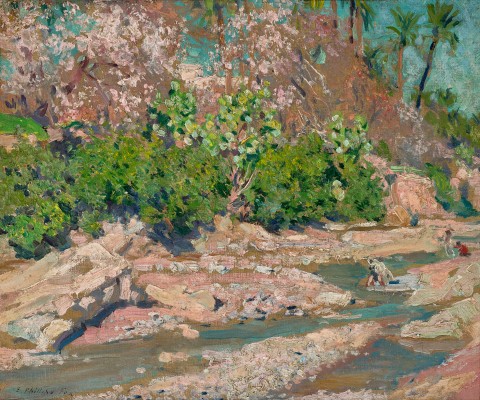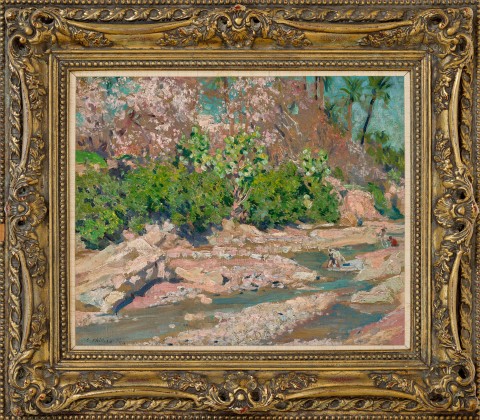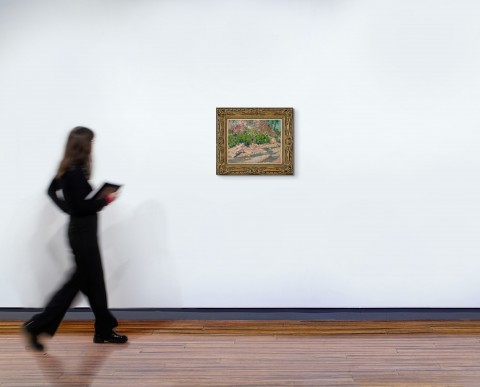FIGURES BESIDE THE CREEK, STANWELL PARK, c.1914
EMANUEL PHILLIPS FOX
oil on canvas on board on composition board
37.0 x 44.0 cm
signed lower left: E. Phillips Fox
Private collection
Joseph Brown Gallery, Melbourne
Sir Leon and Lady Trout, Brisbane, acquired from the above in July 1971
The Collection of Sir Leon and Lady Trout, Christie's, Brisbane, 6 June 1989, lot 175 (as 'Picnic on the Hawkesbury River')
Henry Krongold, Melbourne
The Estate of Paul Krongold, Melbourne
Spring Exhibition 1970, Joseph Brown Gallery, Melbourne, 14 September – 5 October 1970, cat. 10 (illus. in exhibition catalogue, as ‘Picnic by the River’)
Masterworks from the Collection of Sir Leon and Lady Trout, Queensland Art Gallery, Brisbane, 21 September – 14 December 1977, cat. 12 (label attached verso, as ‘Hawkesbury River’)
Zubans, R., E. Phillips Fox: His Life and Art, The Miegunyah Press, Melbourne University Press, Melbourne, 1995, cat. 454, p. 230 (erroneously catalogued as 'Picnic on the Hawkesbury River')
The Creek, Stanwell Park, c.1914, oil on canvas, 37.0 x 44.5 cm, Private collection, illus. in Zubans, R., E. Phillips Fox: His Life and Art, The Miegunyah Press, Melbourne University Press, Melbourne, 1995, p. 166
In a letter to his close friend Hans Heysen in 1911, Emanuel Phillips Fox wrote that in his determination ‘to get some settled sunlight’, he, his wife (the artist Ethel Carrick) and one of Fox’s students went from London ‘to Algiers, from there South into the interior to a place called Bou Saada – where we stayed six weeks – then back to Algiers – then to Tangiers & on to Cadiz – and return’d home through Seville, Cordova, Granada, Toledo and Madrid.’1 On their way back to Paris, they painted in the south of France, further inspired by the sea and coastal towns. Fox’s palette, already enriched by his intimate study of post-impressionist art in Europe, now became even more sun-drenched and high-key in colour. On re-arrival in Australia in 1913, his recent work caused a sensation and he subsequently painted a number of canvases in late January 1914 at popular tourist sites near Sydney, including majestic Stanwell Tops at the southern edge of the Royal National Park, and Stanwell Park below. It is plausible that Fox stayed with his Australian Art Association colleague Edward Officer, who lived nearby.
Figures beside the creek, Stanwell Park, c.1914, is one of seven known paintings that Fox did in the area, all of which appear to have been plein air studies, individually done in single sittings, of the cliffs and the meandering creeks that run through the park. The likely setting is the lower reaches of Stanwell Creek, with the picturesque Kelly’s Falls a short distance away. The painting blazes with light and textured impasto, animated by the figures – likely members of Fox’s and Officer’s families – clambering amongst the rocks. Whilst the artist’s mastery of colour is on full display, particularly in the right-hand section featuring the palm trees, it is also interesting to note other aspects of his technique, particularly in his treatment of the ground. As his colleague Norman Carter described, Figures beside the creek, Stanwell Park was not painted ‘on white prepared canvas, but on duck or sailcloth with a coating of glue size the colour of which would be light fawn or off-white; patches of this were often left unpainted. … In some paintings, particularly if linseed oil had been used to restore the painting, this unpainted sailcloth had darkened – but it had never been white.’2 This particular aspect is detectable amongst the rocks and lower cliff.
In the years prior to 1913, Fox had already established himself as one of this country’s leading artists, having studied at the National Gallery School in Melbourne, then in Paris in the company of Tudor St George Tucker. On their return in 1893, the two men opened the Melbourne Art School, famed for being the most progressive in its day. In subsequent years, Fox was the first Australian to be elected into membership of the Société Nationale des Beaux-Arts, Paris, and the International Society of Painters, Sculptors and Gravers in London, but what is less known is his impact on this country’s earliest modernists. Roland Wakelin would later recall of Fox’s exhibition in Sydney in 1913: ‘We’d never seen colour like that before… this was expression through colour.’3 With a provenance that includes Joseph Brown, Sir Leon and Lady Trout, and the Krongold family, Figures beside the creek, Stanwell Park is a superb example of Fox’s mature painterly technique.
1. E. P. Fox. Letter to Hans Heysen 13.09.1911. Cited in: Zubans, R., E. Phillips Fox: his life and art, Miegunyah Press, Melbourne, 1995, p. 159
2. Roland Wakelin, recounting Norman Carter. Quoted in: Fox, L., E. Phillips Fox: notes and recollections, (self published), Sydney, NSW, 1969, pp. 29 – 30
3. Roland Wakelin, 1968, ibid., p. 29
ANDREW GAYNOR


